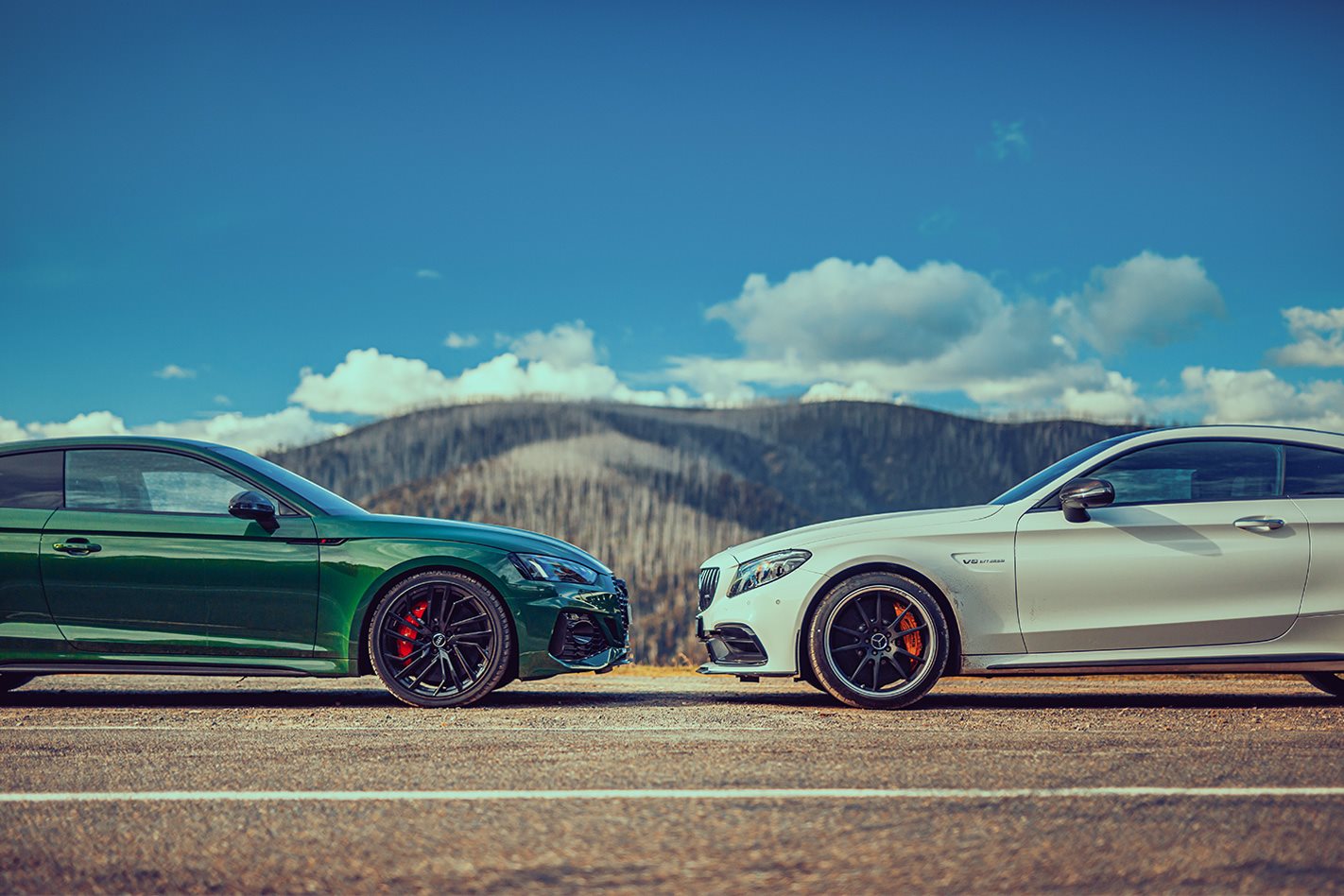Yin versus yang, light versus dark, perhaps even good versus evil. The Mercedes-AMG C63 S Coupe and Audi RS5 Coupe aim for the same goal but their methods of kicking it are almost diametrically opposed.
The radical differences in mechanical philosophies of our two test cars could be seen as a neat metaphor for their equally divergent personalities. In the white corner is the Mercedes-AMG C63 ‘Aero Edition 63’, an Australia-New Zealand exclusive model limited to just 63 units in either Iridium Silver or the Polar White seen here. Sprucing up the exterior is a number of “wind tunnel tested aerodynamic extras” including a bigger rear spoiler, larger front lip and chunky diffuser.
The spoiler, mirror caps, and inserts in the front apron, side skirts and diffuser become carbon fibre, which is also liberally applied to the interior. AMG Performance seats are standard, trimmed in the Aero-exclusive combination of Magma Grey Nappa leather with yellow stripes, the flashes of colour also appearing on the centre console, dash and door trims.
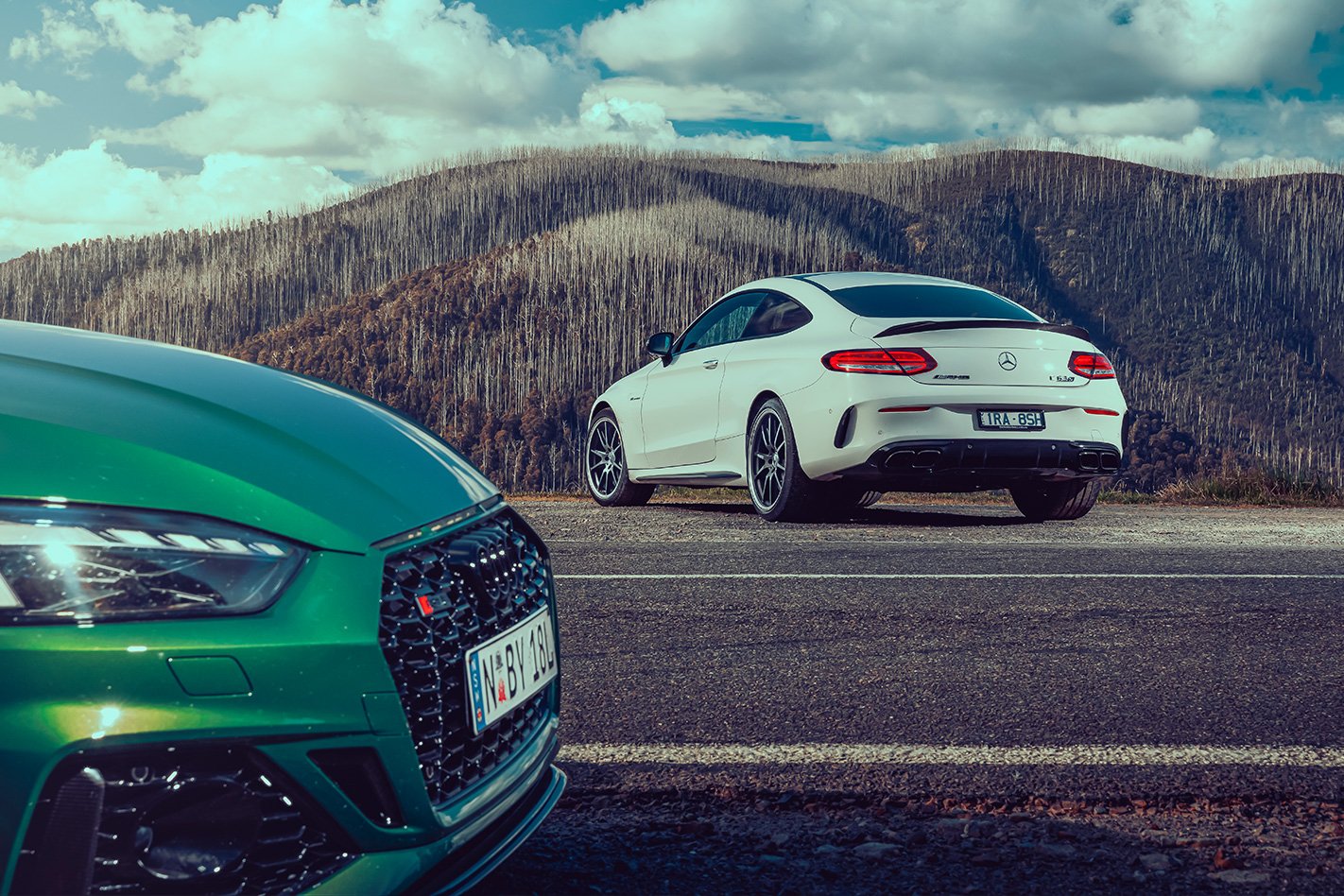
The only mechanical upgrade is the inclusion of carbon-ceramic brakes, giant 402mm composite front discs with the gold six-piston front calipers that identify AMGs so equipped. All told you’re looking at $188,236. This appears to hand the facelifted RS5 a sizeable price advantage as Audi has sliced almost $7000 out of the base price as part of the midlife refresh, which also incorporates revised styling (larger grille, narrower headlights), fancy laser light headlights and every active safety feature under the sun. However, this apparent price advantage doesn’t take into account the Audi options list, which sits salaciously in the corner saying ‘come hither’ to your wallet.
Our test RS5 wears $37,800 worth of extras, which pleasingly brings its total to just $464 more than its AMG opponent at $188,700. The big ticket items are the $13,600 carbon-ceramic brakes and $11,200 carbon styling package that slathers the exterior in carbon in a virtually identical manner to the C63. The RS5 ‘Aero Edition’ if you will.
Turning the roof and engine cover to carbon adds another $4900 and $1200 respectively and dynamic ride control adaptive dampers are a further $4400. Rounding off the total are gloss black wheels ($400), black badges ($700) and matt carbon interior inlays ($1400). Whew. Painted in Sonoma Green, the dark and foreboding colour scheme gives the RS5 a menacing mien.
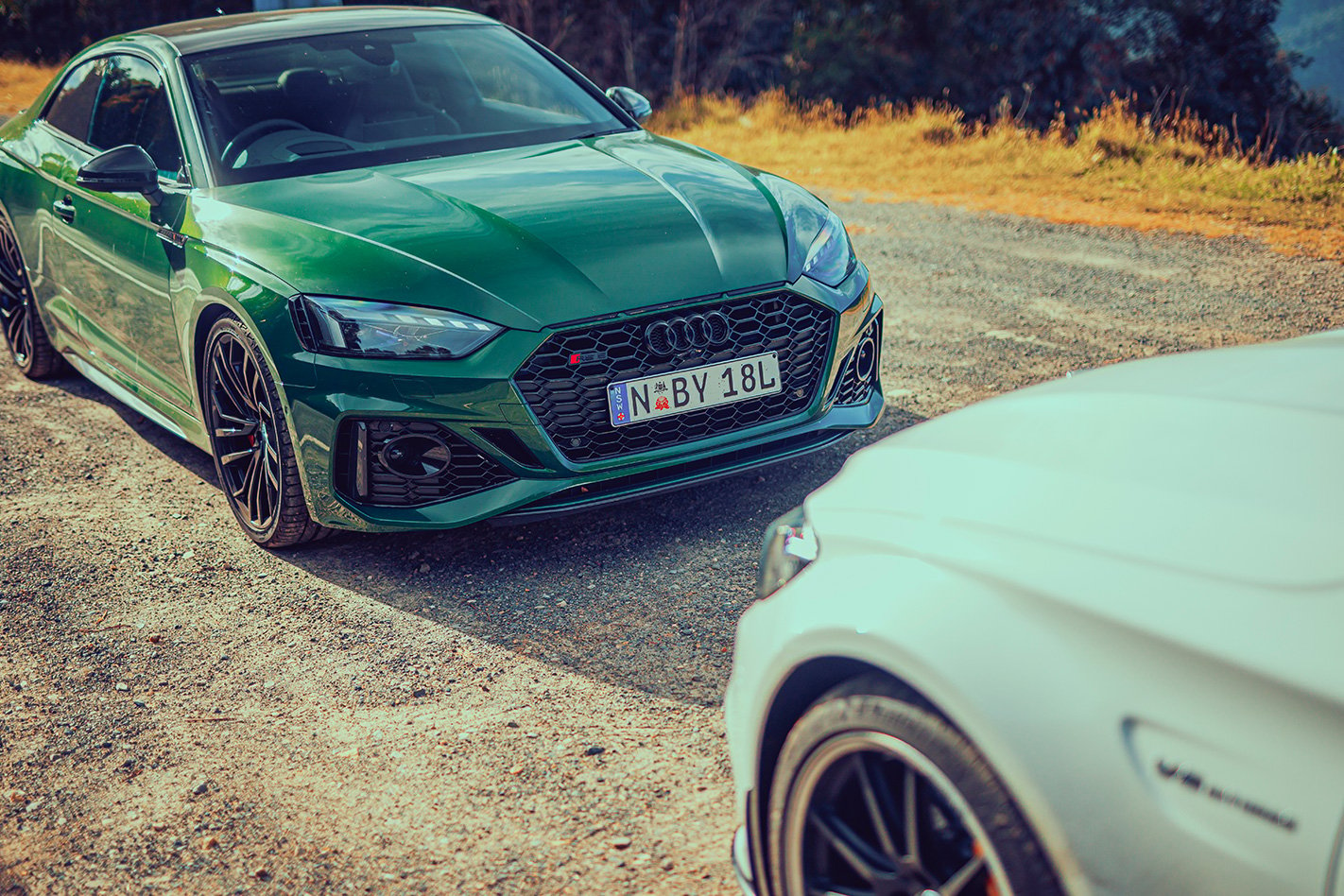
Parked nose to nose with the C63, the Audi is lower, squatter and more muscular. The Mercedes looks sleeker but taller and thinner. The height difference is not an illusion. The AMG stands 41mm taller than the RS5 but also 16mm wider and 28mm longer with an extra 74mm in the wheelbase. Despite this, the Audi is clearly the more practical car. Forgive us for getting all sensible for a second, but the RS5 has a much bigger boot (465L vs 355L) and nicer rear accommodation. The C63 isn’t exactly barren in the back but it’s a child-only zone in terms of space whereas the RS5 offers more room, separate temperature controls and USB charging.
Up front, both are lineball in terms of features and ergonomics, though I prefer the Audi’s steering wheel and its seats offer better support than the AMG’s, for my body type at least. Where the RS5 is clearly superior is its infotainment. The new 10.1-inch MMI touchscreen is as slick and intuitive as the Merc’s touchpad-controlled system isn’t. This might sound like a small thing – you wouldn’t base a purchasing decision on it – but when it’s something you interact with every minute or so of every day it’s the difference between a feeling of relaxation or frustration.
Relaxation is something the RS5 is quite good at; it’s about as undemanding as daily drivers get. The 2.9-litre twin-turbo V6 hums away surreptitiously, the eight-speed automatic occasionally feels like it wants to be a dual-clutch with its stop-start behaviour but is smooth enough, the ride is pliant and refinement is excellent. This is a ‘nice’ car: it looks nice, it feels nice, it drives nice. The AMG is much more naughty. It starts with an anti-social whoompf and idles malevolently, even more so if you select one of the sportier modes.
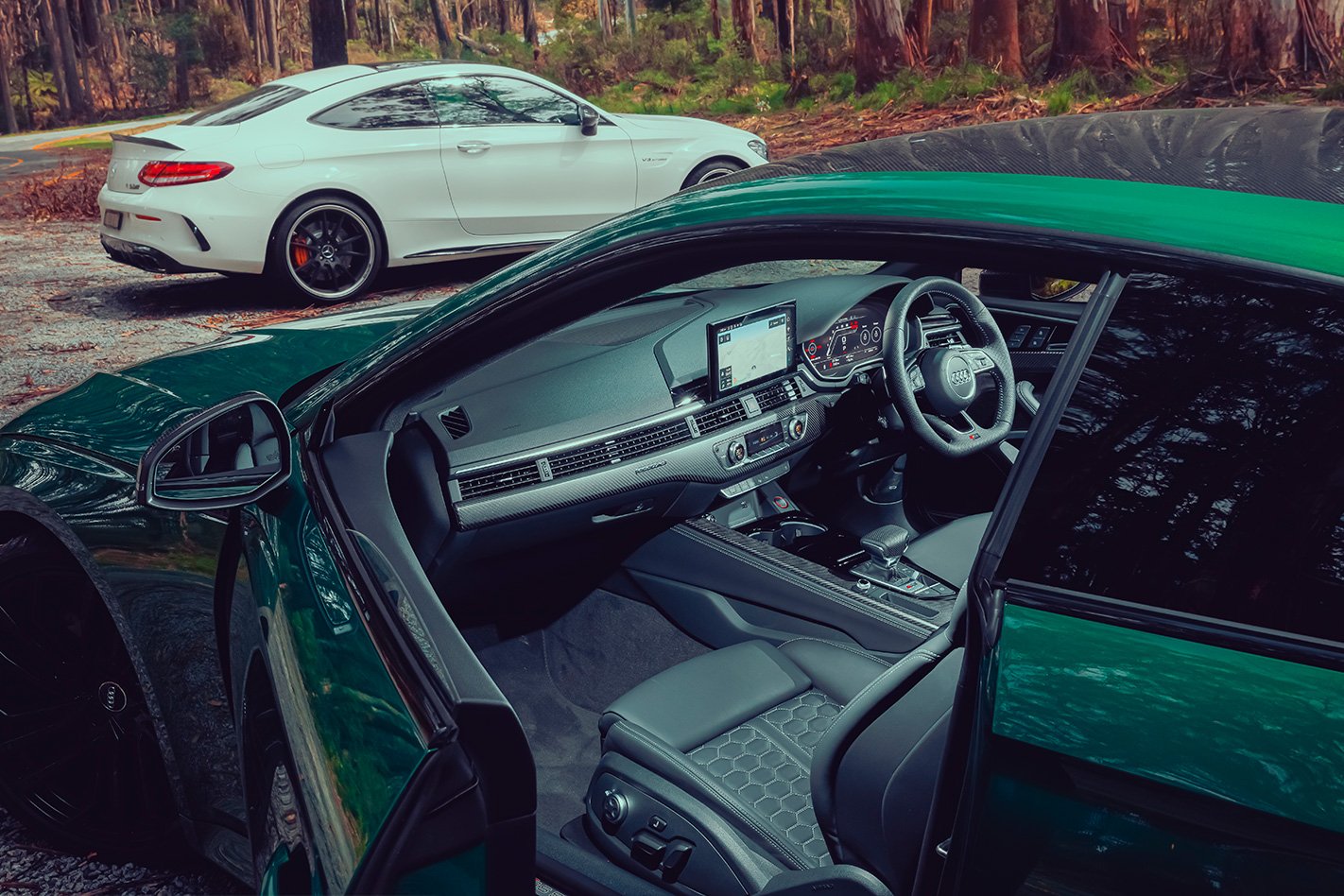
The C63’s mid-life update transformed its ride quality – even Sport mode is probably softer than the old car’s Comfort – but it remains a fairly raw car: road noise is ever-present and sharp bumps and cat’s eyes send audible thumps and buzzes through the body shell. This is one of the ramifications of removing virtually all the rubber bushings out of the bulging rear subframe, which gives the Coupe an extra 50mm of track compared to the C63 sedan.
A happier consequence, however, is fantastic feedback as those rubber bushings are no longer muffling the lines of communication between road and driver. It will probably take some experimentation to settle upon your favoured combination of settings from the many possibilities, which you can then save to the ‘Individual’ mode. Personally, my preference is engine in Race, suspension in Sport, gearbox in manual, exhaust loud and AMG Dynamics in Master, but I’ll come back to that.
Adjusting settings on the fly using the wheel mounted controllers takes a little practice but is also very satisfying, like James Bond fiddling with his latest Q Branch gadgets. Softening the suspension has not only improved the C63’s comfort but also its handling. Whether or not outright grip is greater is a moot point, for it breathes with the road better which increases driver confidence. Setting the dampers to Sport stiffens them enough to control the Merc’s substantial 1725kg weight yet still allows enough body roll to telegraph what the car is doing. It’s fabulous to drive, more controlled than the sedan thanks to not only the extra rear track but also the extra rear rubber, the 285mm Michelin Pilot Super Sports 20mm wider than those on the four-door. They are just about sufficient to contain the monstrous grunt of the 4.0-litre twin-turbo V8.
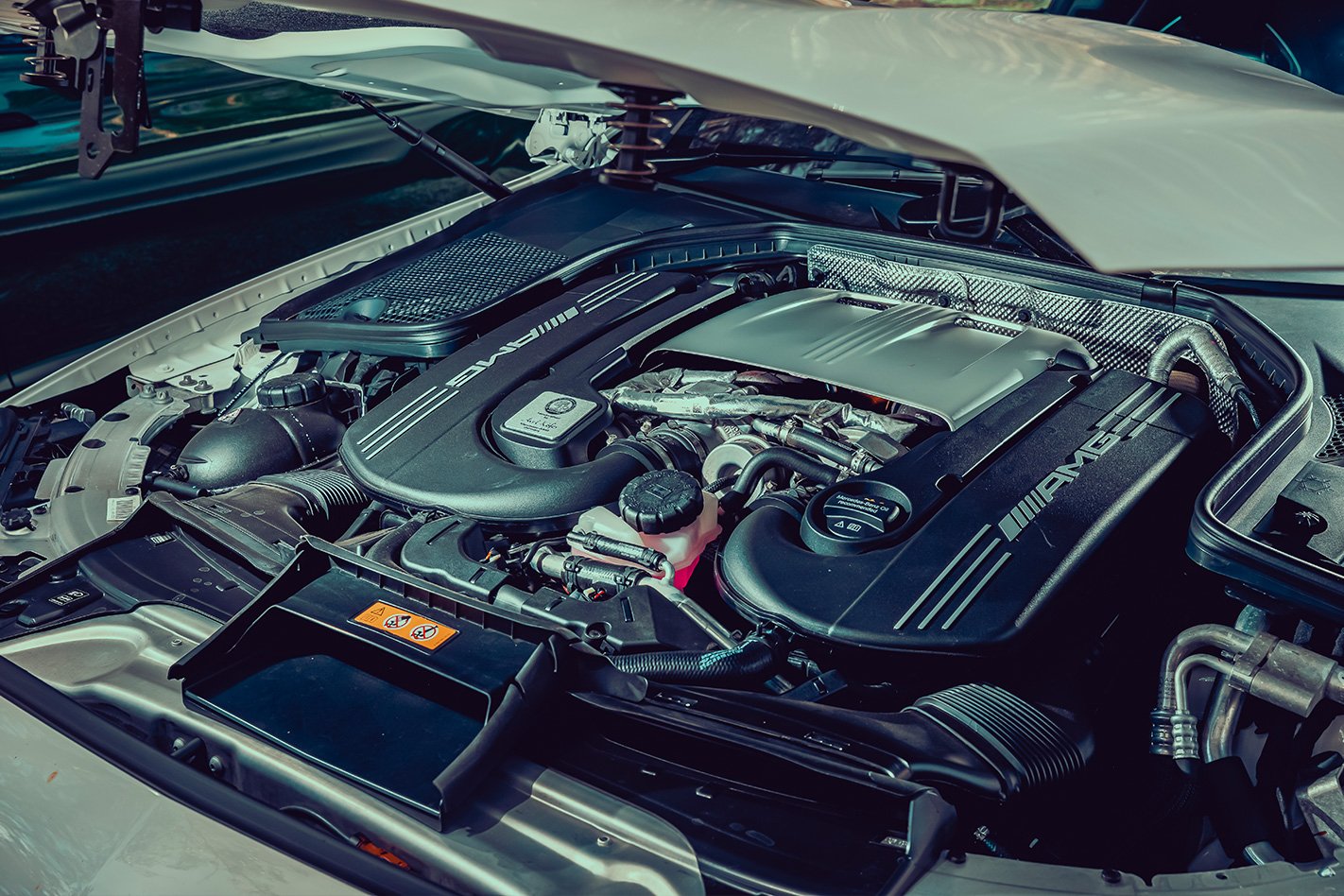
It’s a beast of a powerplant, however, its mountainous mid-range torque does make the top end feel comparatively soft; peak power plateaus from 5500rpm and it’s around this point that you’ll find yourself naturally selecting the next gear. Nevertheless, what the M178 lacks in top end it makes up for with the full gamut of noises, from deep gurgles to a crisp roar with thunderous cracks on the overrun. If, as expected, the next ‘C63’ switches to a turbocharged four-cylinder it’s going to have to be something fairly remarkable as the engine is such a dominant feature of this car’s character. The nine-speed gearbox also plays its part in taming the engine, as the closer ratios mean corners previously taken in second gear with the old seven-speed ’box are now taken in third.
The final line of defence against those 700Nm is the ESP, which is nicely judged in Sports mode or you can turn the system off and activate the 10-stage traction control, but just remember it then only controls wheelspin and not lateral movement! Another inclusion with the facelifted C63 is the AMG Dynamics system. This has four modes – Basic, Advanced, Pro and Master – and, according to AMG, controls the throttle and steering characteristics to improve stability and agility. By taking data from all the various sensors it supposedly reacts to vehicle behaviour before the driver can “with no noticeable intervention of the system”. With apologies to the engineers who developed it, it adds nothing. While driving back-to-back through a set of corners for photography, I cycle through each of the modes in turn and feel no discernible difference in the C63’s responses.
Where it is noticeable is when driving really hard and you realise that now and then the car doesn’t respond to your inputs how you expect it to; never in an untoward way, but when a question is asked and the answer is different to that expected it’s a bit frustrating. Who’s driving this car, me or the computers?
The Audi suffers from a similar problem, though rooted in a different cause. Audi has followed BMW’s lead and added an ‘RS Mode’ button on the steering wheel which cycles through two favourite combinations of settings, but putting everything bar the steering in Dynamic is a good start. Stiffening the dampers ruins the ride but the added body control is necessary, especially through mid-corner bumps. Up to a certain limit, a very high limit, the RS5 is fantastic. It rotates into corners very well, has great balance mid-corner and the surety of all-wheel drive traction on exit.
The engine revs better than the C63’s V8, too, so well that it’s easy to run into the rev limiter in manual mode as you chase a bigger hit of the ever-increasing power. This combination of attributes goads you in to pushing harder, to loosen the ESP into Sports mode and attempt to get the RS5 dancing around, but at this point it starts to display flat feet rather than twinkle toes. The primary culprit feels to be the all-wheel drive system. Turn in, point the car towards the corner exit, apply the throttle to help finish the rotation and…nothing. Rather than slightly overloading the rear tyres like Porsche and BMW the Audi comes over all sensible and diverts too much power to the front resulting in a safe, neutral-to-slight-understeer balance. Safe, not fun. Undeterred, you try again, and again, searching for the desired result until eventually it becomes clear that it will remain elusive. Another issue: quickly shut the throttle from 100 percent to zero and drivetrain shunt rears its head, the RS5 lurching forward slightly.

Let’s be clear, though, despite detailing each car’s flaws here both are hugely capable, the RS5 in particular. Having switched from the Mercedes it becomes obvious that it wasn’t just Ed Andy’s prodigious driving ability that was allowing the Audi to stick to the C63’s rear bumper with relative ease. It has at the very least comparable performance and that performance is easier to extract, but it’s nothing like as satisfying to drive hard as the AMG.
Equally, the gulf between the two in day-to-day driving is just as wide in favour of the Audi. With one caveat: the C63 Coupe is always exciting. It struggles with refinement, but you’re going to drive it in Race mode everywhere anyway because you’ll laugh every time the rear wheels spin up in the wet or the exhaust booms reverberate off buildings.
Really, these are two very different cars for two very different buyers. AMG fans will find the RS5 boring and Audi lovers will think the C63 uncouth and as such personal preferences will dictate which you’ll buy. Were the two parked side-by-side outside my house, the Audi would be the pick for any drive where I don’t want to ‘think’: commuting to the office, long interstate trip, weekend winery visit.
For all other occasions, it’d be the C63. And that’s why it wins.
Nosy Parker: A third option is imminent
A representative from Munich is conspicious in its absence from this test with the first G82 BMW M models scheduled to arrive in Australia towards the end of Q2 2021. Nevertheless, with what we know so far we can make some speculative judgements on where BMW’s latest and greatest will slot in.
While there will be a manual, rear-drive M4 for the purposes of this test we would have nabbed an M4 Competition. Like the RS5 it uses a 3.0-litre twin-turbo six-cylinder (though a straight-six in the BMW’s case) but with 375kW/650Nm it’s closer to the AMG in outright grunt. Based on our experience with the S58 in the X3 M/X4 M the BMW would best the Audi for noise but fail to match the AMG, though outright performance should be lineball as the M4 Competition weighs exactly the same as the C63 Coupe: 1725kg.
Dynamics are much tougher to predict. BMW’s M xDrive AWD system is much more playful than Audi’s quattro but it remains to be seen how controlled the rear-drive M4 is and how much feedback it provides. Ditto with the ride quality.
Like the RS5, the M4 Competition’s entry price of $159,900 is reasonably sharp, but to bring it up to the same spec as its fellow Germans tested here you’d need to tick the ‘M Carbon Package’ box which adds carbon brakes, seats and exterior trinketry which balances the ledger somewhat, bring the total price to $185,900. We’ll find out the true verdict early in the new year.


